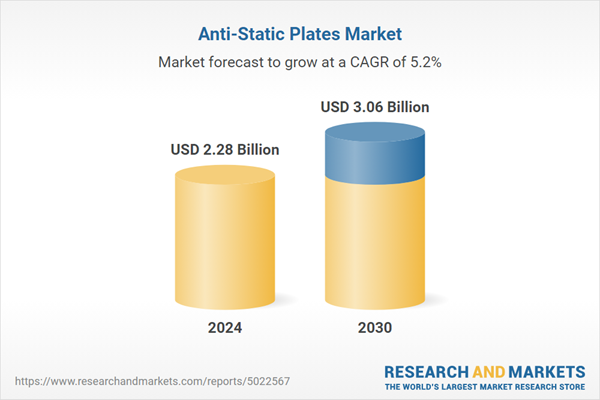Speak directly to the analyst to clarify any post sales queries you may have.
10% Free customizationThis report comes with 10% free customization, enabling you to add data that meets your specific business needs.
Key Market Drivers
Growing Demand of Anti-Static Plates in Electronics Industry
Anti-static plates, or electrostatic discharge (ESD) protection plates, are vital in safeguarding delicate electronic components by preventing static electricity buildup. Their use is widespread in electronics manufacturing and handling processes, where ESD events can cause significant damage, product malfunctions, and even fire hazards. According to the Electrostatic Discharge Association (ESDA), ESD-related failures account for around 8% of production losses, with associated costs ranging from USD 10 to over USD 1,000 depending on the failure point in the supply chain. In response, over 80% of electronics manufacturers now follow global ESD compliance standards such as ANSI/ESD S20.20 and IEC 61340. Additionally, OEMs are tightening audit protocols, mandating certified ESD-safe environments as a requirement for supplier partnerships, further reinforcing the critical role of anti-static plates in production processes.Key Market Challenges
Disruptions in Global Supply Chain
The global anti-static plates market is currently facing mounting challenges due to widespread disruptions across supply chains. These disruptions stem from various sources including geopolitical instability, natural disasters, and lingering effects of the COVID-19 pandemic. As the market relies on a complex network of suppliers for raw materials and components, any interruption within this chain can lead to significant delays, cost increases, and reduced product availability. Such impacts are especially felt in industries dependent on timely deliveries and consistent quality - like electronics, automotive, and construction - where anti-static plates are crucial. These supply chain issues threaten to stall production, inflate prices, and limit the growth potential of the anti-static plates market globally.Key Market Trends
Growing E-commerce and Packaging
The exponential rise of e-commerce has transformed global logistics, significantly boosting the demand for protective packaging materials. Electronics, a dominant category in online retail, are particularly susceptible to electrostatic discharge (ESD), amplifying the need for ESD-safe packaging like anti-static plates. As direct-to-consumer shipments continue to grow, manufacturers and logistics providers are turning to anti-static solutions to ensure product integrity during transit. With return rates for electronics often exceeding 30%, the handling, testing, and repackaging of returned items further necessitate reliable ESD protection. Anti-static plates are now integral in returnable trays, automated handling systems, and protective dunnage, especially in fulfillment centers. Their increasing role in ensuring both product safety and operational efficiency positions them as a strategic material within the evolving global e-commerce and logistics ecosystem.Key Market Players
- Mitsubishi Chemical Corporation
- Sumitomo Bakelite Co. Ltd.
- MISUMI Group Inc
- Energetic Industry Co. Ltd.
- Seikisui Chemical GmbH
- C.I. Takiron Corporation
- SciCron Technologies
- Korea Plate Co Ltd
- Korea Polymer Co., Ltd.
- Nextech Systems, Inc.
Report Scope:
In this report, the Global Anti-Static Plates Market has been segmented into the following categories, in addition to the industry trends which have also been detailed below:Anti-Static Plates Market, By Type:
- Single Side Anti-Static Plates
- Both Side Anti-Static Plates
Anti-Static Plates Market, By Material:
- Stainless Steel
- PVC
- PET
- Acrylic
- Polycarbonate
- Others
Anti-Static Plates Market, By End User:
- Electronics
- Automotive
- Petroleum
- Textile
- Rubber
- Aviation & Military
- Others
Anti-Static Plates Market, By Region:
- North America
- United States
- Canada
- Mexico
- Europe
- France
- United Kingdom
- Italy
- Germany
- Spain
- Asia-Pacific
- China
- India
- Japan
- Australia
- South Korea
- South America
- Brazil
- Argentina
- Colombia
- Middle East & Africa
- South Africa
- Saudi Arabia
- UAE
Competitive Landscape
Company Profiles: Detailed analysis of the major companies present in the Global Anti-Static Plates Market.Available Customizations:
With the given market data, the publisher offers customizations according to a company's specific needs. The following customization options are available for the report.Company Information
- Detailed analysis and profiling of additional market players (up to five).
This product will be delivered within 1-3 business days.
Table of Contents
Companies Mentioned
- Mitsubishi Chemical Corporation
- Sumitomo Bakelite Co. Ltd.
- MISUMI Group Inc
- Energetic Industry Co. Ltd.
- Seikisui Chemical GmbH
- C.I. Takiron Corporation
- SciCron Technologies
- Korea Plate Co Ltd
- Korea Polymer Co., Ltd.
- Nextech Systems, Inc.
Table Information
| Report Attribute | Details |
|---|---|
| No. of Pages | 180 |
| Published | July 2025 |
| Forecast Period | 2024 - 2030 |
| Estimated Market Value ( USD | $ 2.28 Billion |
| Forecasted Market Value ( USD | $ 3.06 Billion |
| Compound Annual Growth Rate | 5.2% |
| Regions Covered | Global |
| No. of Companies Mentioned | 10 |







